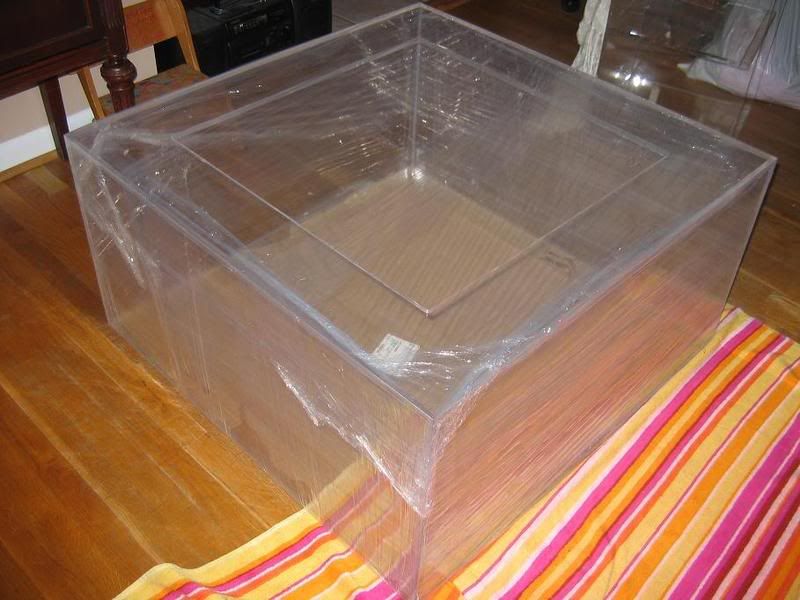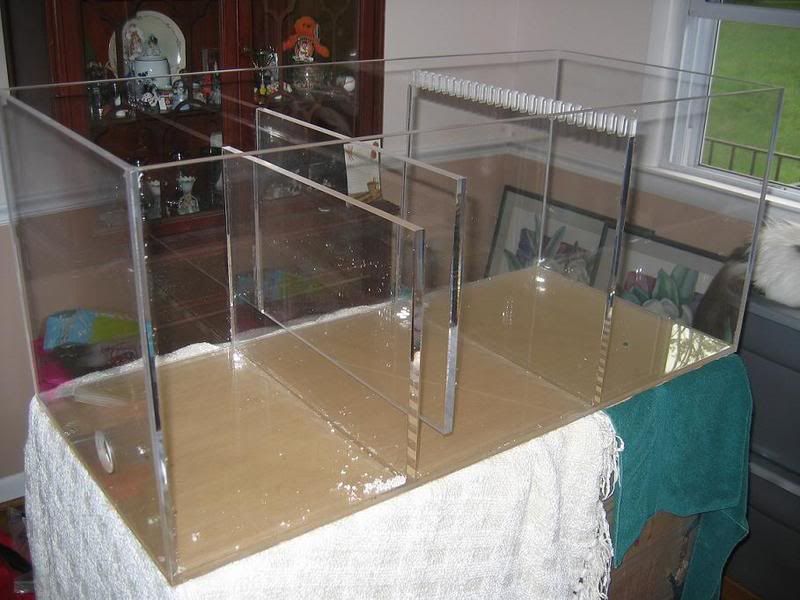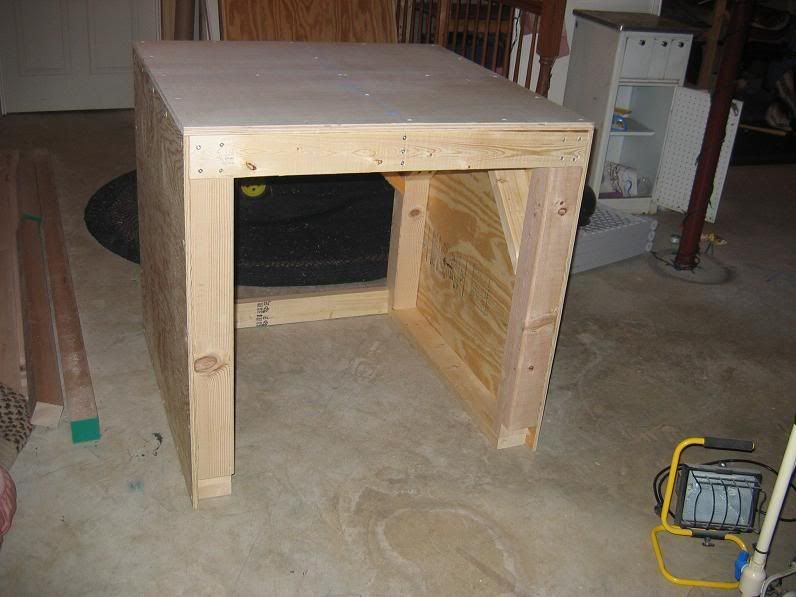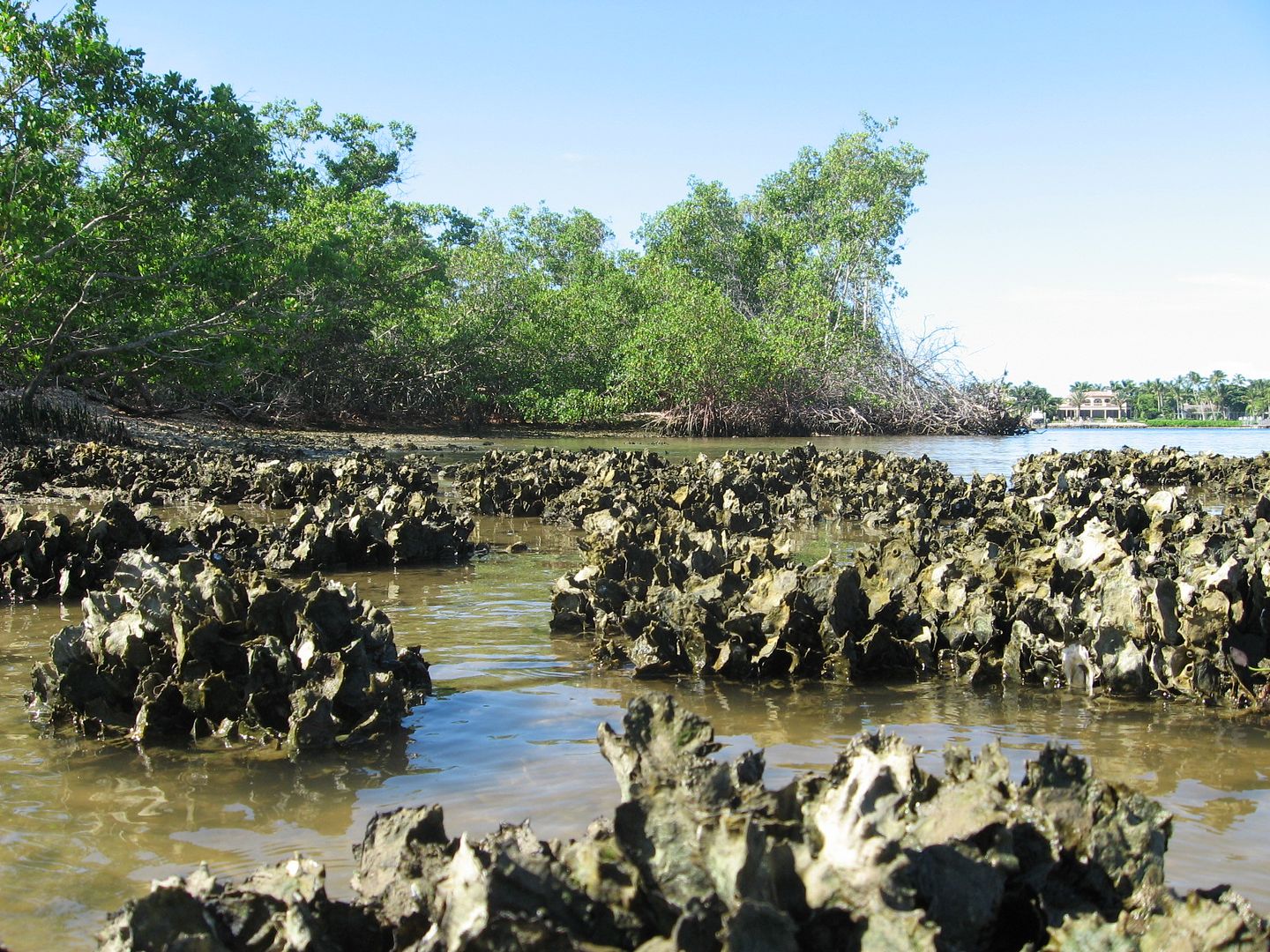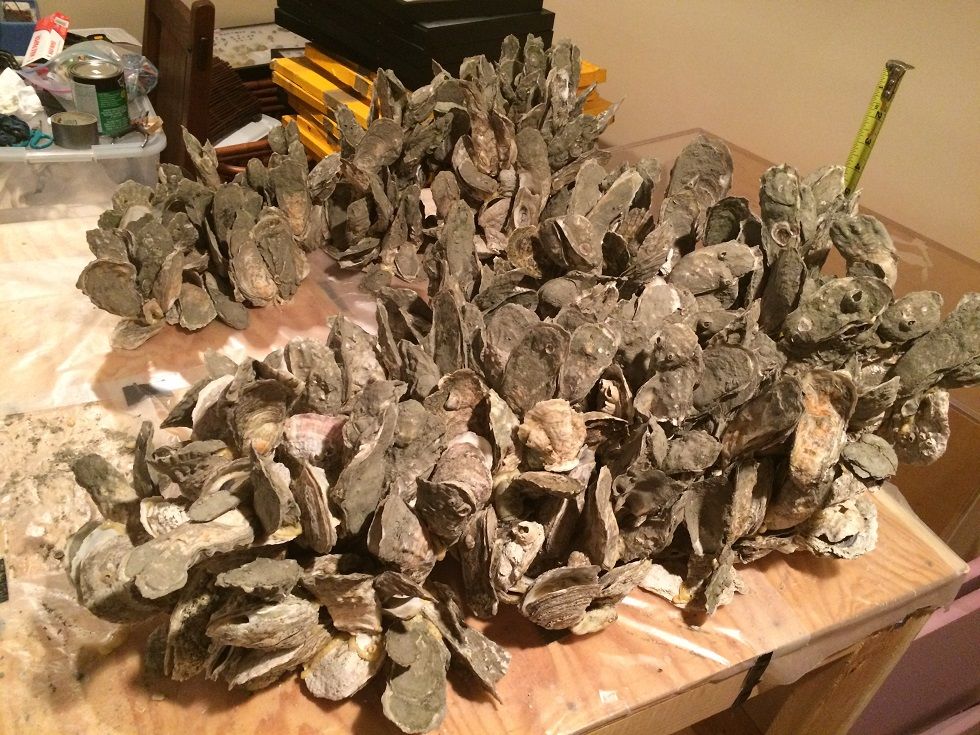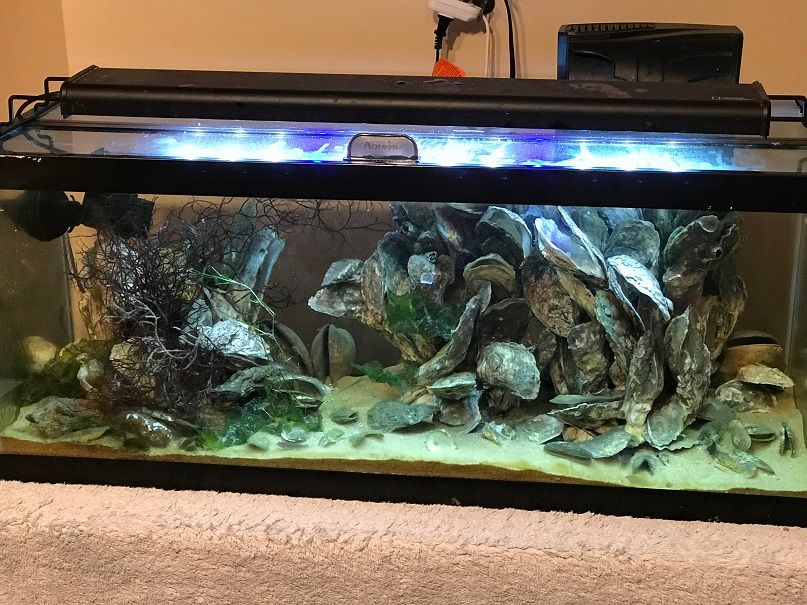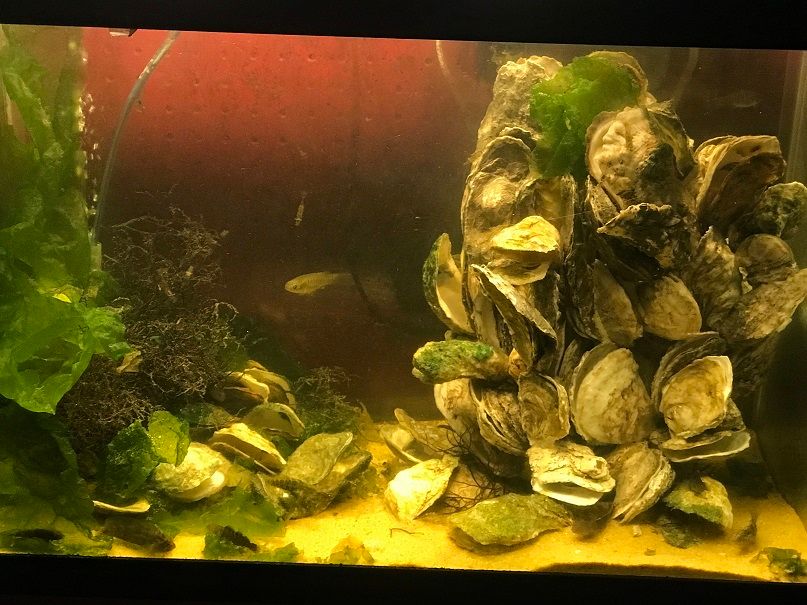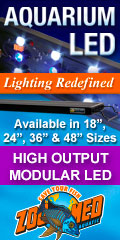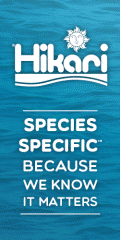Hi everyone! I just found this site today and it seems like a really cool place to share info. Not only am I building my dream tank using locally collected species, but I'm trying to duplicate as close as possible an oyster reef biotope.
Concept:
One of my dreams was to duplicate the oyster reef environment of the Chesapeake Bay as best I can without much predation. The feature fish will be the striped blenny, Chasmodes bosquianus. All other organisms that I collect and keep will be fun, but the focus is on the blennies. So, at first, this will be like a fish only tank with macroalgae, but eventually I'd like to turn this into an entire Chesapeake Bay oyster reef as much as possible. I will not keep blue crabs, toadfish, any other predatory fish, or mantis shrimp. If it doesn't eat blennies, I may keep it.
I had a tank and sump built for this a several years back, and almost finished a stand but personal troubles in my life caused me some delay in the build. The tank is an acrylic 101 gallon cube (36"X36"X18"), and the sump/refugium is 36"X18"17". I hope to gather "live" sand from the Chesapeake Bay, and I'm going to try a Chesapeake Bay mud for the refugium. I will introduce macroalgae early in the process in the sump and perhaps the display tank as well. I want to have plenty of life in this tank prior to adding the fish.
Once the tank is established, I hope to obtain additional filtration using live filter feeding organisms, oysters and perhaps mussels, tunicates, sponges, etc. although I realize that I'd have to find some way to supplement feeding. The sump will hopefully be a good supply of planktonic critters, although I may try to build a plankton reactor later on if that doesn't work.
My stocking list will include, but not be limited to:
I'll attempt another reefkeeping technique, live rock. However, the rock in my area of the bay typically is composed of clay and is of no biological use. I've built some DIY rock out of cement, and will place themin the bay at my friends place. After a while, once they're full of life, I'll place them in my sump. This rock, plus the live sand as my substrate should adequately address the biological filtration needs of this tank quickly.
Ecological Simulation:
The Chesapeake bay is brackish and the salinity varies based on rainfall and runoff, but these fish have bred in captivity with a specific gravity of 1.015 or so. The range where I will collect varies between 1.015-1.020 depending on rainfall, time of year, etc. I'll keep my tank in this range, probably more on the salty side for now. Eventually, I may bring it to full salt, although varying salinity might help control parasitism. I read one article that you can vary the specific gravity as much as 0.002 per day. I don't plan on doing it that much, but, I think that I don't have to worry about the fish being sensitive do changes of this over time.
Temperatures range from winter cold water in the 40's F to brutally warm summer temps in the upper 80's F in the shallows of the bay. Chasmodes bosquianus and the other fish are also found in Florida waters, so I don't think that temperature is an issue and won't need a heater or chiller. Water parameters in the Chesapeake are constantly changing too, making it tough for sensitive species to thrive there, but these changes are no problem for species represented in this biotope. I will keep my mind open to the possibility of using a chiller if I can't get the blennies to spawn, but I don't think it will be necessary. We will see.
Lighting:
I'm looking at using freshwater LED lighting that is suitable for a planted tank. It's not wattage and intensity that I'm after, but rather I want to duplicate lunar cycles, daylight and nighttime lighting transitions and seasonal variances in an attempt to induce spawning behavior.
Water Quality:
I plan to not use a skimmer and hope to cultivate macro algae for nutrient export. Eventually, I'll try keeping filter feeding organisms, especially in the sump, once the tank is established. I think that most of the invertebrates will be hydroids, hardy anemones, tunicates, oysters, barnacles and mussels, and other filter feeders. Eventually I may use supplemental planktonic feed products perhaps. These inverts don't need as much light. Bay waters are pretty murky and filled with nutrients (both natural and, unfortunately, man introduced). Of course, frequent testing and water changes will be in my regimen to make sure that things go well. My main concern isn't so much the inverts here, but getting my fish to breed and thrive. If the biotope works out and I can keep all of these critters successfully, then so much the better. Top off water will come via using an RO/DI unit.
Current:
Another thing that I'd like to simulate is the tide and water movements. I don't want to do this by lowering and raising water levels, but rather by using varying currents. I can use directional flow to simulate water moving in and out of the mouth of a tidal creek for example, where a dock with an oyster reef may reside and form the habitat that I'm trying to duplicate. I think that I can do this by having powerheads on timers. Not only will this help keep the critters feeling at home, frequent current and no dead zones in the tank should help with algae control.
In addition to placing DIY rock in the bay, I think that I can also make a basket/milk crate and fill it with oyster shells to collect animals. I have permission to a couple good collecting spots to place these. The oyster shell basket will allow me to easily collect various oyster reef fish. I may also get more species diversity this way, including invertebrates. Dip nets work well, especially for tough to catch fish that won't hide in the oyster shells.
Other issues:
One issue surrounds the collection of live oysters. In Maryland, I have to be careful that if I collect my own, to collect in designated areas and during the correct open season. Even though they aren't for consumption, I need to make sure that I'm compliant with local laws which change frequently. A better option would be to buy some fresh oysters directly from a waterman, right off the boat. It will cost me some money, but at least I'd know that I'm legal, and it's good for the local economy.
I think that in this system there may not be a wrong way to do it simply because these animals are so hardy. That said, I'd like to create a successful system and give these animals optimal conditions. This system won't have the color and beauty seen in the typical reef aquarium, but it will have it's own appeal and beauty, and quite unique from other tanks. Actually, the male striped blenny gets extremely colorful during spawning! If that happens then I'll know I'm on the right track.
The creation of the ecosystem is a goal, but having an accurate and complete one might be out of the question. The blennies are the feature fish, so those will be my main concern, and that is creating a good breeding habitat with the simulation of an accurate biotope. So, my goal of keeping filter feeding invertebrates might not be doable. I'm going to give it a try though.
I have no idea what problems I will encounter. Algae blooms are a primary concern. I hope that macroalgae will outcompete the nuiscance algae. Another concern is parasitism. Between running the tank fallow prior to adding fish, and having a QT system already in place, parasitism should be kept to a minimum.
As far as the aquascaping (or rockscaping) goes, I've made progress. I collected oyster shells from restaurants (even bought and shucked some of my own), matched as many as I could, glued them together into what I think are realistic looking oyster cultches to build the reef. I used Gorilla Glue to glue them all together into a reef. It was a long and tedious process, but I am satisfied with the result. I posted a picture of the final product below. Included in the reef are several dozen oyster shells that are glued in an open position, some with larger gaps, some smaller. The gaps are the exact size of gaps that the blennies (larger gaps almost 1/2" wide) and gobies (smaller gaps about 3/8" wide) prefer for breeding.
Concept:
One of my dreams was to duplicate the oyster reef environment of the Chesapeake Bay as best I can without much predation. The feature fish will be the striped blenny, Chasmodes bosquianus. All other organisms that I collect and keep will be fun, but the focus is on the blennies. So, at first, this will be like a fish only tank with macroalgae, but eventually I'd like to turn this into an entire Chesapeake Bay oyster reef as much as possible. I will not keep blue crabs, toadfish, any other predatory fish, or mantis shrimp. If it doesn't eat blennies, I may keep it.
I had a tank and sump built for this a several years back, and almost finished a stand but personal troubles in my life caused me some delay in the build. The tank is an acrylic 101 gallon cube (36"X36"X18"), and the sump/refugium is 36"X18"17". I hope to gather "live" sand from the Chesapeake Bay, and I'm going to try a Chesapeake Bay mud for the refugium. I will introduce macroalgae early in the process in the sump and perhaps the display tank as well. I want to have plenty of life in this tank prior to adding the fish.
Once the tank is established, I hope to obtain additional filtration using live filter feeding organisms, oysters and perhaps mussels, tunicates, sponges, etc. although I realize that I'd have to find some way to supplement feeding. The sump will hopefully be a good supply of planktonic critters, although I may try to build a plankton reactor later on if that doesn't work.
My stocking list will include, but not be limited to:
- Striped blennies (Chasmodes bosquianus) - will be the feature fish of this tank. I hope to get them to breed, so there will be at least half a dozen of these.
- Hysoblennius hentzi - feather blenny if I'm lucky enough to catch any. They're aggressive, so I am undecided on them. I had one a long time ago, and it was an awesome fish.
- Naked goby (Gobiosoma bosc)
- Skilletfish (Gobiesox strumosus)
- Northern pipefish (Syngnathus fuscus) maybe, once my tank is estabished.
- Other possible fish that I may add include seahorses, a hogchoker, killifish, mummichogs, sheepshead minnows, and if I'm really lucky, maybe a tropical stray spotfin butterflyfish.
- Ghost shrimp, hermit crabs, snails, etc. for clean up crew that live in the bay.
- And just about any critter that comes in on the rocks eventually. I'll run the tank fallow for 6 weeks after the tank cycles to reduce parasitism before adding fish. I will QT fish prior to adding them to the tank.
I'll attempt another reefkeeping technique, live rock. However, the rock in my area of the bay typically is composed of clay and is of no biological use. I've built some DIY rock out of cement, and will place themin the bay at my friends place. After a while, once they're full of life, I'll place them in my sump. This rock, plus the live sand as my substrate should adequately address the biological filtration needs of this tank quickly.
Ecological Simulation:
The Chesapeake bay is brackish and the salinity varies based on rainfall and runoff, but these fish have bred in captivity with a specific gravity of 1.015 or so. The range where I will collect varies between 1.015-1.020 depending on rainfall, time of year, etc. I'll keep my tank in this range, probably more on the salty side for now. Eventually, I may bring it to full salt, although varying salinity might help control parasitism. I read one article that you can vary the specific gravity as much as 0.002 per day. I don't plan on doing it that much, but, I think that I don't have to worry about the fish being sensitive do changes of this over time.
Temperatures range from winter cold water in the 40's F to brutally warm summer temps in the upper 80's F in the shallows of the bay. Chasmodes bosquianus and the other fish are also found in Florida waters, so I don't think that temperature is an issue and won't need a heater or chiller. Water parameters in the Chesapeake are constantly changing too, making it tough for sensitive species to thrive there, but these changes are no problem for species represented in this biotope. I will keep my mind open to the possibility of using a chiller if I can't get the blennies to spawn, but I don't think it will be necessary. We will see.
Lighting:
I'm looking at using freshwater LED lighting that is suitable for a planted tank. It's not wattage and intensity that I'm after, but rather I want to duplicate lunar cycles, daylight and nighttime lighting transitions and seasonal variances in an attempt to induce spawning behavior.
Water Quality:
I plan to not use a skimmer and hope to cultivate macro algae for nutrient export. Eventually, I'll try keeping filter feeding organisms, especially in the sump, once the tank is established. I think that most of the invertebrates will be hydroids, hardy anemones, tunicates, oysters, barnacles and mussels, and other filter feeders. Eventually I may use supplemental planktonic feed products perhaps. These inverts don't need as much light. Bay waters are pretty murky and filled with nutrients (both natural and, unfortunately, man introduced). Of course, frequent testing and water changes will be in my regimen to make sure that things go well. My main concern isn't so much the inverts here, but getting my fish to breed and thrive. If the biotope works out and I can keep all of these critters successfully, then so much the better. Top off water will come via using an RO/DI unit.
Current:
Another thing that I'd like to simulate is the tide and water movements. I don't want to do this by lowering and raising water levels, but rather by using varying currents. I can use directional flow to simulate water moving in and out of the mouth of a tidal creek for example, where a dock with an oyster reef may reside and form the habitat that I'm trying to duplicate. I think that I can do this by having powerheads on timers. Not only will this help keep the critters feeling at home, frequent current and no dead zones in the tank should help with algae control.
In addition to placing DIY rock in the bay, I think that I can also make a basket/milk crate and fill it with oyster shells to collect animals. I have permission to a couple good collecting spots to place these. The oyster shell basket will allow me to easily collect various oyster reef fish. I may also get more species diversity this way, including invertebrates. Dip nets work well, especially for tough to catch fish that won't hide in the oyster shells.
Other issues:
One issue surrounds the collection of live oysters. In Maryland, I have to be careful that if I collect my own, to collect in designated areas and during the correct open season. Even though they aren't for consumption, I need to make sure that I'm compliant with local laws which change frequently. A better option would be to buy some fresh oysters directly from a waterman, right off the boat. It will cost me some money, but at least I'd know that I'm legal, and it's good for the local economy.
I think that in this system there may not be a wrong way to do it simply because these animals are so hardy. That said, I'd like to create a successful system and give these animals optimal conditions. This system won't have the color and beauty seen in the typical reef aquarium, but it will have it's own appeal and beauty, and quite unique from other tanks. Actually, the male striped blenny gets extremely colorful during spawning! If that happens then I'll know I'm on the right track.
The creation of the ecosystem is a goal, but having an accurate and complete one might be out of the question. The blennies are the feature fish, so those will be my main concern, and that is creating a good breeding habitat with the simulation of an accurate biotope. So, my goal of keeping filter feeding invertebrates might not be doable. I'm going to give it a try though.
I have no idea what problems I will encounter. Algae blooms are a primary concern. I hope that macroalgae will outcompete the nuiscance algae. Another concern is parasitism. Between running the tank fallow prior to adding fish, and having a QT system already in place, parasitism should be kept to a minimum.
As far as the aquascaping (or rockscaping) goes, I've made progress. I collected oyster shells from restaurants (even bought and shucked some of my own), matched as many as I could, glued them together into what I think are realistic looking oyster cultches to build the reef. I used Gorilla Glue to glue them all together into a reef. It was a long and tedious process, but I am satisfied with the result. I posted a picture of the final product below. Included in the reef are several dozen oyster shells that are glued in an open position, some with larger gaps, some smaller. The gaps are the exact size of gaps that the blennies (larger gaps almost 1/2" wide) and gobies (smaller gaps about 3/8" wide) prefer for breeding.


